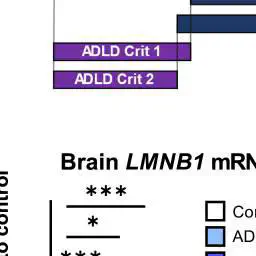An oligodendrocyte silencer element underlies the pathogenic impact of lamin B1 structural variants

A non-coding silencer near LMNB1 constrains lamin B1 expression specifically in oligodendrocytes via CTCF‑mediated looping and PRC2 recruitment. Loss of this element—through upstream deletions or tandem duplications—drives overexpression and explains the tissue‑specific pathology of autosomal dominant leukodystrophy (ADLD).
Abstract (concise summary)
Investigating families with LMNB1 tandem duplications that surprisingly do not show demyelination, alongside ADLD tissues, CRISPR‑edited cell lines, and mouse models, the authors identify an oligodendrocyte‑specific silencer. This element contains CTCF sites that form 3D chromatin loops and recruit PRC2, reducing LMNB1 transcription in oligodendrocytes. Loss of the silencer (by upstream deletion) or functional uncoupling (with certain duplications) elevates LMNB1 expression and underpins ADLD’s cell‑type specificity and pathogenesis.
Key takeaways
- Mechanism: CTCF‑anchored looping plus PRC2‑mediated repression keeps LMNB1 low in oligodendrocytes; removing the element lifts repression.
- Evidence: Multi‑family human genetics, ATAC/ChIP, CRISPR editing, reporter assays, RNA/protein readouts, and mouse models converge on the same mechanism.
- Clinical lens: Explains why LMNB1 dosage changes cause CNS‑restricted demyelination, despite broad LMNB1 expression.
- Therapeutic angle: Restoring the silencer’s function (synthetic silencers/insulators, epigenetic targeting) could normalize LMNB1 in ADLD.
Suggested citation
Nmezi B, Rodriguez Bey G, DeFrancesco Oranburg T, et al. An oligodendrocyte silencer element underlies the pathogenic impact of lamin B1 structural variants. Nat Commun. 2025;16(1):1373. doi:10.1038/s41467-025-56378-9.